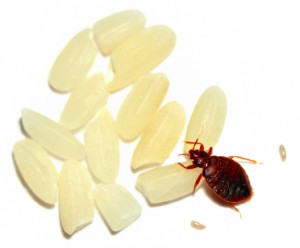Bed Bug Facts
Appearance:
- Eggs: Iridescent, white 1/32 inch long.
- Nymphs: 8 legs, translucent, very pale brown, they gradually become darker brown as the molt and mature.
- Adults: Reddish brown to brown, flat in shape and swells after feeding. Up to 3/16 inch long.
Habitat:
- Favorable temperatures are 70 -80F. They can survive temperatures of 14F for at least 5 days and die in very high temperatures. Bed bugs are nocturnal, and prefer to hide in dark areas during the day and feed at night. Bed bugs typically hide in the bed linens (bed skirts, sheets), mattress, headboard, bed frame and crack and tears in the wallpaper. While bed bugs would prefer to hide near the human host, they have also been found inside box springs, behind pictures, baseboards, electrical outlets, phone jacks, phones, alarm clocks, cable boxes, phones, moldings, drapery folds, sofas, chairs, suitcases, backpacks, stuffed toys, laundry, laundry hampers, and even more.
Behavior:
- Bed bugs are nocturnal blood sucking insects that prefer feeding on humans. Bed Bugs can be surprisingly fast moving when disturbed or eager to feed. They are attracted to warmth, carbon dioxide (a gas humans exhale) and a certain mix of chemicals. When a bed bug feeds, it will inject the victim with an anesthetic and an anticoagulant, enabling them to find an appropriate sized blood vessel. Each bed bug may bite 3-5 times in feeding and each feeding may last 3-15 minutes. Bed bugs breeding is called traumatic sex, in which a males knife like penis punctures the females abdomen and inseminates the female. The female will be bred many times and she will can become frustrated and move to another location laying eggs and starting a new nest. Females lay eggs continuously through out her lifetime. A well-fed female will lay up to 500 eggs throughout her life.
Facts:
Human DNA can be recovered form up to 90 days of feeding; this study enables researchers to identify the person the bed bug fed upon. Researchers have found that bed bugs can have been infected with at least 28 human pathogens, including MRSA, Viruses, HIV, Hepatitis B, and a protozoon. Bed Bugs have not been shown to transmit diseases.
The National Pest Management Association named San Francisco as one of the worst cities in the country for bed bug infestations.
One in five Americans has had a bed bugs infestation in their home or knows someone who has encountered bed bugs in their home or hotel.
Bed Bugs have even been found in even in high-end stores on Rodeo Drive, Beverly Hills, Ca.
Bed bugs attack at night. The bugs inject the person with a pain killer and then an anticoagulant. The feeding last 5-10 minutes.
A female will lay 200 – 400 eggs in a lifetime. The young mature in about two months.

